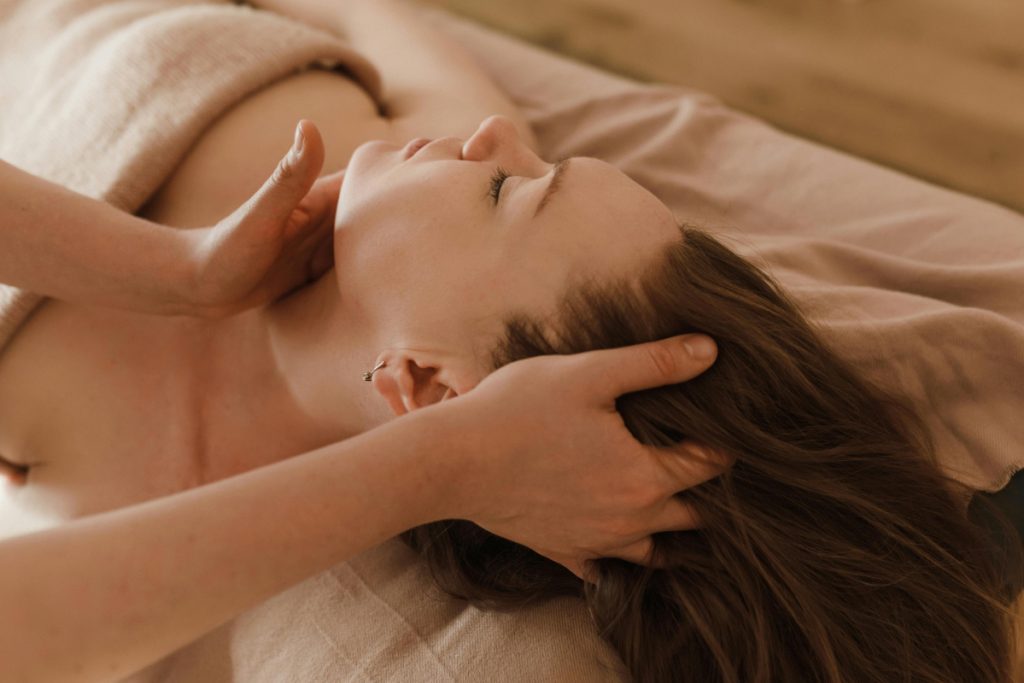Headache referral patterns can cause pain that feels like it starts in your neck, jaw, or behind your eyes. These patterns happen when tight muscles in the neck, shoulders, or face send pain to other parts of the head. They’re more common than most people realize, and many in Edmonton come to our clinic looking for relief. If this sounds familiar, acupuncture may be a helpful next step.
Looking for relief? Book a free consultation with our Edmonton based acupuncture clinic to see how we can help you feel better.
What Are Headache Referral Patterns?
Headache referral patterns happen when a tight or sore muscle sends pain to a different area of your body. For example, a knot in your shoulder could make it feel like you have a headache near your eye or temple. These pain patterns come from trigger points, small, tight spots in your muscles. When they’re active, they can cause pain in places that may seem unrelated.
Here are some muscles that commonly cause headache referral pain and what their pain can feel like:
Sternocleidomastoid (SCM):
This muscle can send pain to the eyes, forehead, or cheeks. It often feels like a sinus headache.Suboccipitals:
These muscles cause pain behind the eyes or at the base of the skull.Upper Trapezius:
Tension here can lead to pain in the temple or behind one eye.Levator Scapulae:
This muscle often causes one-sided pain at the base of the skull or along the neck.Masseter / Temporalis:
These jaw muscles refer pain to the jaw, ear, or temples. This is common with jaw clenching or TMJ issues.Splenius Capitis / Cervicis:
Tightness in these muscles can cause pain on the top or back of the head. It may feel like a tight helmet.
Experts have studied these patterns for years. They were first described in a well-known medical book, Travell & Simons’ Myofascial Pain and Dysfunction. These patterns are a big reason people experience confusing or hard-to-treat headaches.

What Causes These Trigger Point Headaches?
Many things can lead to these tight muscles and headache referral patterns, including:
Poor posture (like looking down at a screen for too long)
Stress or clenching your jaw
Past injuries to your neck (like whiplash)
Sleeping in awkward positions
Hormone changes or stress-related tension
Holding tension in your muscles from pain or anxiety
When this happens repeatedly, the muscles get tight and stay that way. This cuts off blood flow, traps nerves, and creates pain that spreads into your head.
Want to see the research? Read the full 2012 study on how acupuncture helps reduce chronic headache and muscle pain here.
How Acupuncture Can Help with Headache Referral Patterns
Acupuncture is a safe and natural treatment that can help reduce these kinds of headaches. It works by calming the nervous system, improving blood flow, and releasing tight muscles. Here’s how acupuncture helps with headache referral patterns:
It Releases Tight Muscles and Trigger Points
When we place small needles into the tight spots, the muscle can twitch and relax. This helps loosen it, easing pain and improving movement. Studies show acupuncture can reduce muscle tightness and tenderness.
It Boosts Blood Flow
Acupuncture increases blood flow to the muscles in your head, neck, and shoulders. This helps bring in fresh oxygen and remove waste products, which reduces pain and inflammation.
It Lowers Pain Signals
The needles help your body release natural chemicals, such as endorphins and serotonin. These help reduce pain and make you feel calmer. Acupuncture also helps slow down the nerves that send pain messages to your brain.
It Targets the Root Cause (TCM View)
In Traditional Chinese Medicine (TCM), headache referral patterns may occur when factors such as stress, poor circulation, or hormonal shifts disrupt your body’s function. Acupuncture can help fix these deeper causes by calming the nervous system, improving circulation, and relaxing your muscles.
Research shows acupuncture can effectively reduce muscle tightness and deactivate myofascial trigger points. A 2009 study published in Archives of Physical Medicine and Rehabilitation found that acupuncture is effective for managing myofascial pain, primarily when it arises from trigger points.

What to Expect During a Headache Referral Patterns Treatment
At Monica Patt Acupuncture in Edmonton, we look at your whole health picture. If you come to us for headaches, your session may include acupuncture points on the neck, jaw, scalp, and shoulders to help release tight muscles. We may also use electro‑acupuncture when deeper muscle work is needed. Some people benefit from cupping or gua sha, which helps improve blood flow in tight areas. We also talk about helpful habits, such as posture, jaw clenching, hydration, and simple stretches.
Everyone responds in their own way, but many people start to feel some relief within a few sessions. Larger changes usually show up after three to six treatments.
Struggling with hormone-related headaches? Read our blog on Acupuncture for Hormonal Migraines to learn how treatment can help you find lasting relief.
Find Relief from Headache Referral Patterns with Acupuncture in Edmonton
If your headaches feel like they start in your neck, jaw, or shoulders, you may be dealing with headache referral patterns. These types of headaches often come from tight muscles that need help releasing. Acupuncture offers a safe, effective way to treat the root of the pain and help you feel better without relying on medication.
Let’s talk about your headaches, look at what might be causing muscle tension or nerve irritation, and build a treatment plan that targets your symptoms. Book a consultation with our Edmonton clinic today.
Disclaimer: This blog is for educational purposes only and is not a substitute for medical advice. Acupuncture for headache referral patterns is a safe, drug-free treatment that may help reduce muscle tension and pain. At Monica Patt Acupuncture, we take a whole-body approach and often work alongside other healthcare providers to support your overall well-being.